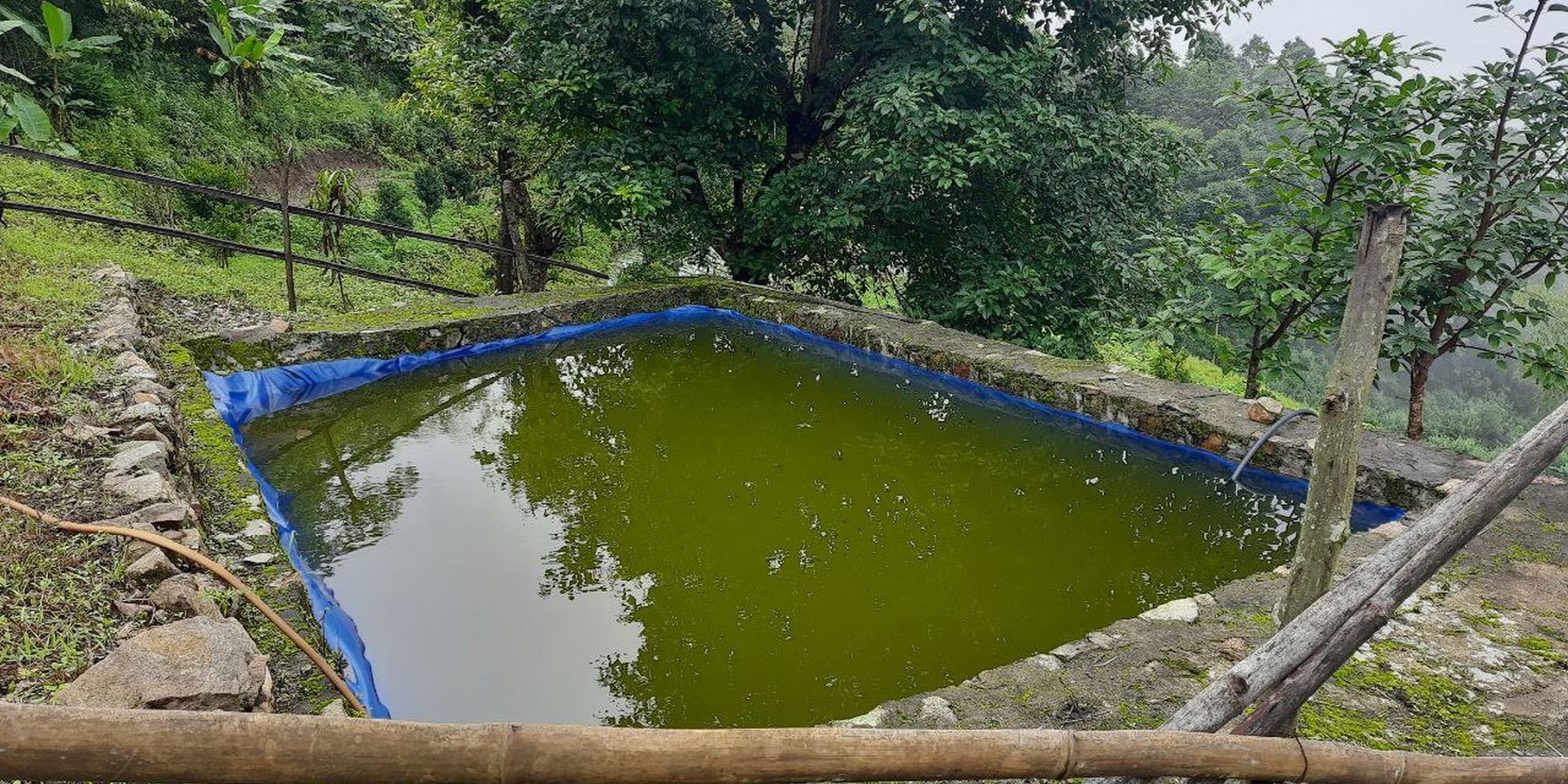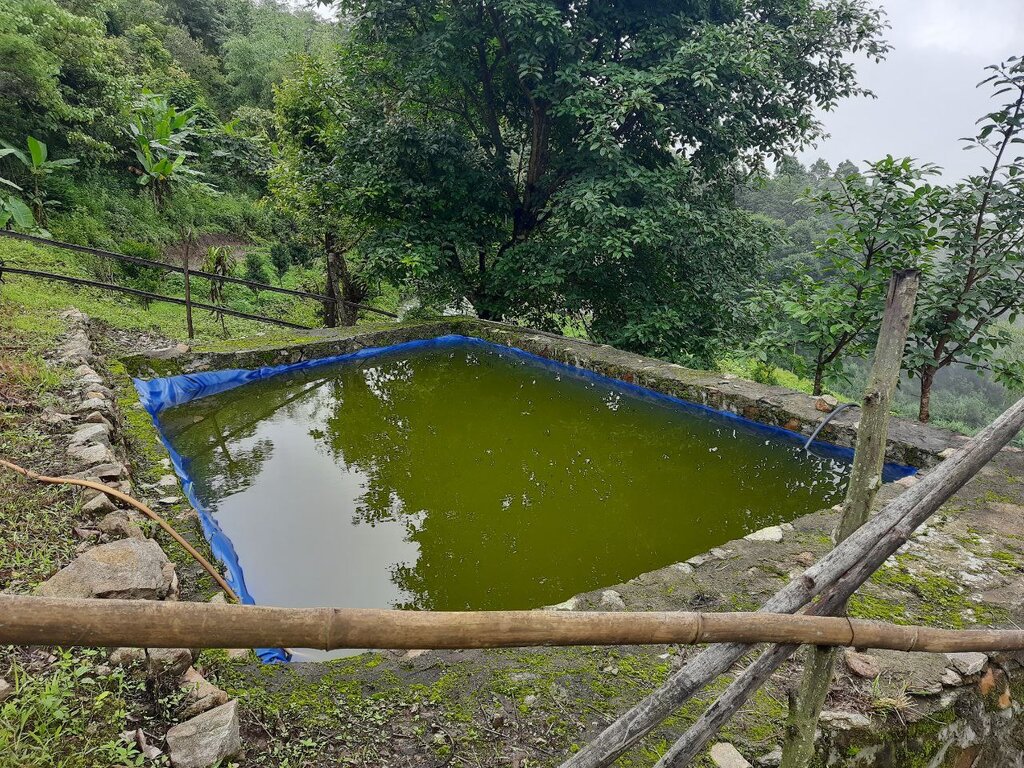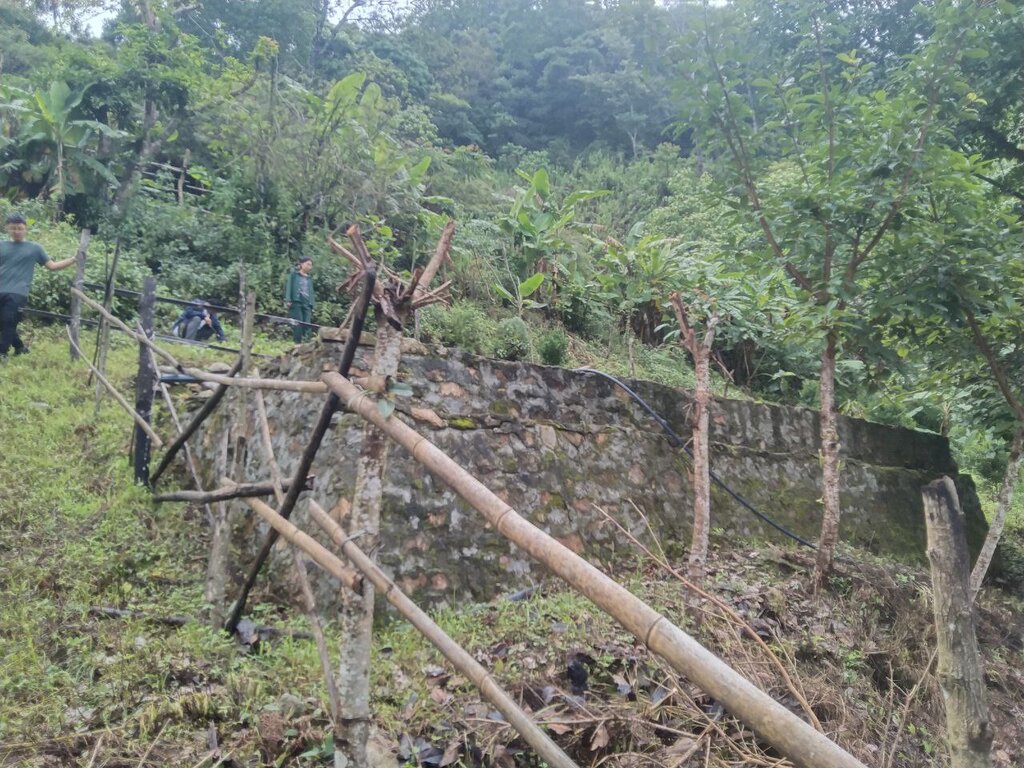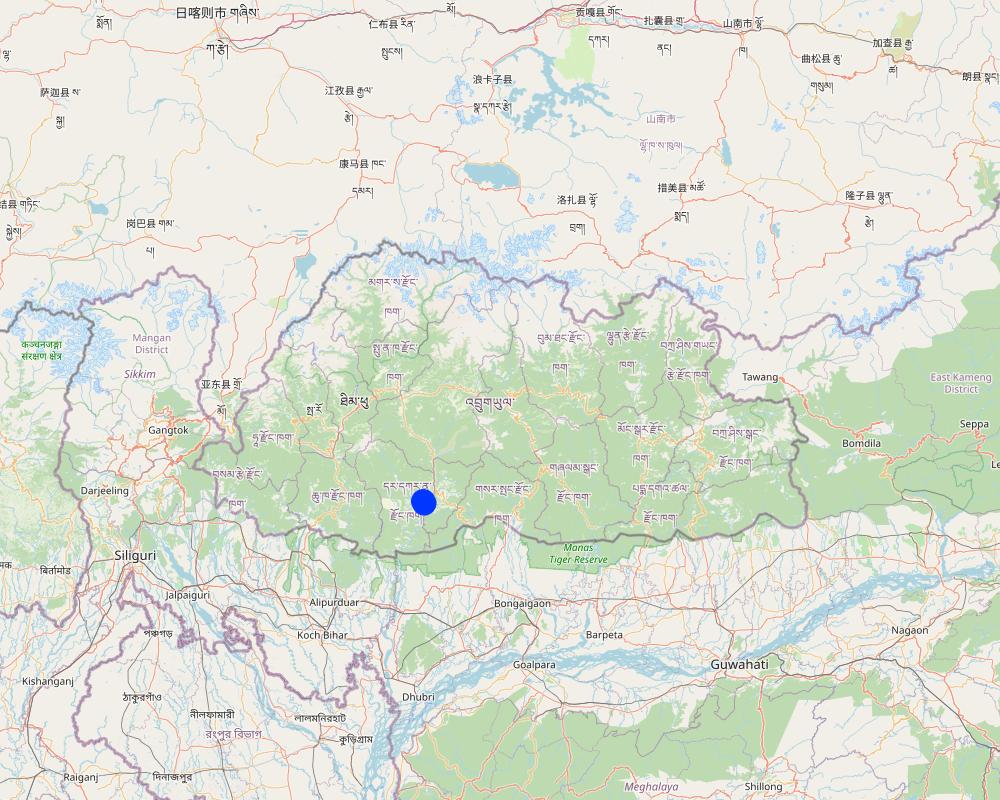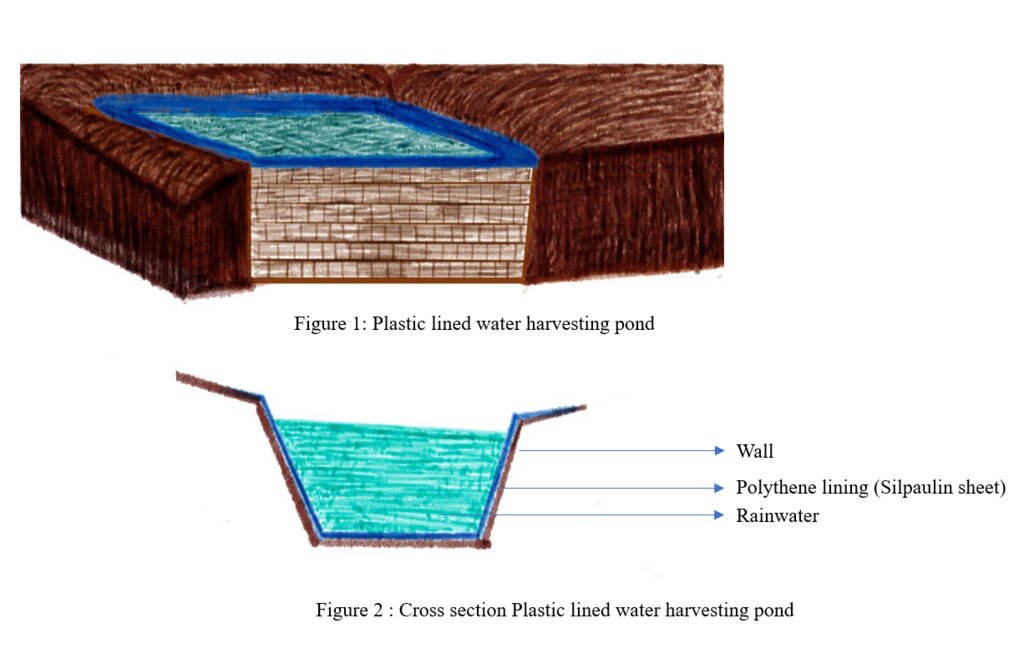Low-Cost Plastic-Lined Water Harvesting Pond [بوتان]
- تاريخ الإنشاء:
- تحديث:
- جامع المعلومات: Nima Dolma Tamang
- المحرر: Kuenzang Nima
- المراجعون: William Critchley, Rima Mekdaschi Studer, Joana Eichenberger
Chhusho Laglen Thabtey Zowai Chhu Sakni Zing (ཆུ་ཤོག་ལག་ལེན་འཐབ་སྟེ་བཟོ་བའི་ཆུ་བསག་ནིའི་རྫིང་།)
technologies_6821 - بوتان
عرض الأقسام
توسيع الكل طي الكل1. معلومات عامة
1.2 تفاصيل الاتصال بالأشخاص الرئيسيين لمصدر المعلومات والمؤسسات المشاركة في تقييم وتوثيق التقنية
الشخص (الأشخاص) الرئيسي لمصدر المعلومات
مستخدم الأرض:
Sangay
بوتان
اسم المشروع الذي سهّل توثيق/تقييم التقنية (إذا كان ذلك على صلة)
Strengthening national-level institutional and professional capacities of country Parties towards enhanced UNCCD monitoring and reporting – GEF 7 EA Umbrella II (GEF 7 UNCCD Enabling Activities_Umbrella II)اسم المؤسسة (المؤسسات) التي سهلت توثيق/تقييم التقنية (إذا كان ذلك على صلة)
National Soil Services Centre, Department of Agriculture, Ministry of Agriculture & Livestock (NSSC) - بوتان1.3 الشروط المتعلقة باستخدام البيانات الموثقة من خلال WOCAT
يوافق جامع المعلومات والشخص (لاشخاص) الرئيسي لمصدر المعلومات على الشروط المتعلقة باستخدام البيانات الموثقة من خلال WOCAT:
نعم
1.4 إعلان بشأن استدامة التقنية الموصوفة
هل التقنية الموصوفة هنا تمثل مشكلة فيما يتعلق بتدهور الأراضي، بحيث لا يمكن إعلانها تقنية مستدامة لإدارة الأراضي؟:
كلا
1.5 الإشارة إلى الاستبيان (الاستبيانات) حول مناهج الإدارة المستدامة للأراضي (موثقة باستخدام WOCAT)
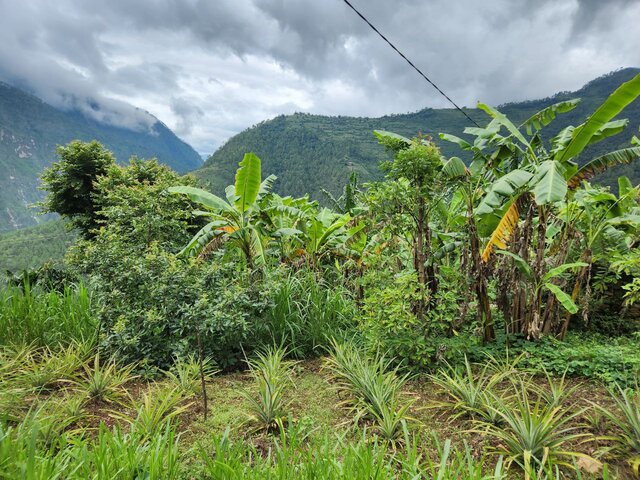
Climate-Smart Village Approach [بوتان]
Climate change has become inevitable, and there is a need to address this impending danger. In the Climate-Smart Village (CSV) approach, land users in Ngaru-Pongtang have implemented several technologies and innovations to address climate change impacts, and the programme has worked with 50 households on a total area of 137 …
- جامع المعلومات: ONGPO LEPCHA
2. وصف تقنيةالإدارة المستدامي للأراضي
2.1 وصف مختصر للتقنية
تعريف التقنية:
Low-cost plastic-lined water harvesting ponds collect and store rain and overland flow water for agricultural and domestic purposes in the dry season. They are both economic and efficient.
2.2 وصف تفصيلي للتقنية
الوصف:
Low-cost plastic-lined water harvesting pond are used to collect and store rain or overland flow water for agricultural purposes in the dry season. They are economic and efficient. These ponds are required in the context of irrigation water shortages. Although rainfall has been projected to be increasing (NCHM, 2017), irrigation water shortage was - and continues to be - one of the major constraints in crop production (IHPP, 2017).
Water from precipitation and surface water sources is lost due to inadequate collection and storage. Villages at the top of the hills, in particular, suffer from acute irrigation as well as drinking water shortages. To tap and collect wastewater, rainwater, and water from other perennial and non-perennial sources, low-cost plastic lined water harvesting ponds are proposed. This water can be used during the dry or “lean” season for agricultural as well as household purposes.
The proposed model pond (plastic sheet size; 9m * 7m) costs less than Nu. 25, 000 (USD 315) for construction but can hold more than 27, 000 litre of water. The same dimension of pond if constructed using concrete, would cost more than Nu. 1, 19, 000 (USD 1500). Furthermore a 10, 000 litre synthetic tank available on the market costs more than Nu.35, 000.
Irrigation water shortage results in fallow lands. It is reported that 6,400 acres (2,600 ha) of irrigable land was left fallow in 2016 and 26 % of the total households surveyed were affected by irrigation water shortages (DoA, 2016). By reducing fallow land and increasing crop production, this technology could be a stepping stone towards food self-sufficiency – as well as providing water for consumption by people and livestock.
Though a similar technology is said to have introduced in the country many years ago, the present form of the technology was introduced to Barshong gewog in Tsirang Dzongkhag by the ‘Himalica’ pilot project in 2014. However, the proposed technology has been modified and improved to suit to the topography and needs of farmers in Bhutan. The proposed pond design is a reverse truncated square pyramid shape unlike the cuboid shape ponds of ICIMOD’s. The pond is designed in such way as to increase pond stability and ease of construction.
Concrete tanks require specific construction methods and faults can develop with ice freezing and expanding in cracks in tank walls during the winter (Slater, 2011). Plastic (silpaulin) sheet lined ponds are leak-proof and primarily depend on the longevity of the plastic sheet unlike concrete tanks. Concrete water tanks, (especially elevated tanks) are also prone to damage due seismic activities (Housner, 1963).
The low-cost plastic lined water harvesting pond adopted is cheap, environmentally friendly, and has positive social impacts. It reduces irrigation water constraints, addresses fallow land problems, and supplements water for domestic purposes. The technology is a tool for reducing poverty, expanding cultivated land and increasing food self-sufficiency resulting in a healthier and happier society.
2.3 صور التقنية
2.5 البلد/المنطقة/المواقع التي تم تنفيذ التقنية فيها والتي يغطيها هذا التقييم
البلد:
بوتان
المنطقة/الولاية/المحافظة:
Dagana Dzongkhag
مزيد من التفاصيل حول الموقع:
Pangserpo Chiwog, Drujeygang Gewog
حدد انتشار التقنية:
- يتم تطبيقها في نقاط محددة/ تتركز على مساحة صغيرة
هل يقع موقع/مواقع التقنية في منطقة محمية بشكل دائم؟:
كلا
التعليقات:
The technology is located in the land users field.
Map
×2.6 تاريخ التنفيذ
اذكر سنة التنفيذ:
2019
2.7 إدخال التقنية
حدد كيف تم إدخال التقنية:
- من خلال المشاريع/ التدخلات الخارجية
التعليقات (نوع المشروع، الخ):
The technology was initiated by Agriculture Research and Development Centre Bajo through fund support of Food Security and Agriculture Productivity Project of the World Bank. Drujegang, Kana and three blocks of Lhamoidzingkha sub-district of Dagana districts were selected as the project sites.
3. تصنيف تقنية الإدارة المستدامي للأراضي
3.1 الغرض الرئيسي ( الأغراض الرئيسية) للتقنية
- تحسين الإنتاج
- الحد من تدهور الأراضي ومنعه وعكسه
- التكيف مع تغير المناخ/الظواهر المتطرفة وآثارها
- خلق أثر اقتصادي مفيد
- خلق أثر اجتماعي مفيد
3.2 نوع (أنواع) استخدام الأراضي الحالية حيث يتم تطبيق التقنية
استخدامات الأراضي مختلطة ضمن نفس وحدة الأرض:
نعم
حدد استخدام الأراضي المختلطة (المحاصيل / الرعي / الأشجار):
- الحراجة الزراعية

الأراضي الزراعية
- زراعة سنوية
- زراعة الأشجار والشجيرات
الزراعة السنوية - حدد المحاصيل:
- الحبوب البقولية والبقول- الفاصوليا
- المحاصيل الجذرية/الدرنية - البطاطس
- الخضروات - الخضروات الورقية (السلطات، الملفوف، السبانخ، وغيرها)
- خضروات - اخرى
- الخضروات - الخضروات الجذرية (الجزر والبصل والشمندر وغيرها)
- chilli, onion
زراعة الأشجار والشجيرات -حدد المحاصيل:
- الموالح (الحمضيات)
عدد مواسم الزراعة في السنة:
- 2
هل يتم ممارسة الزراعة البينية؟:
نعم
إذا كانت الإجابة بنعم، حدد المحاصيل التي يتم زراعتها بشكل بيني:
Vegetables intercropped within citrus orchard
هل تتم ممارسة تناوب المحاصيل؟:
نعم
إذا كانت الإجابة بنعم، حدد:
The land users grow different crops in the same area. For example, if they plant potatoes this year, they plant beans next year.
3.3 هل تغير استخدام الأراضي نتيجة لتنفيذ التقنية؟
هل تغير استخدام الأراضي نتيجة لتنفيذ التقنية؟:
- لا (تابع مع السؤال 3.4)
3.4 إمدادات المياه
إمدادات المياه للأرض التي يتم تنفيذ التقنية عليها:
- مختلط بعلي-مروي
3.5 مجموعةالإدارة المستدامة للأراضي التي تنتمي إليها هذه التقنية
- حصاد المياه
- إدارة الري (بما في ذلك إمدادات المياه والصرف الصحي)
3.6 التدابير التقنية في مجال إلادارة المستدامة للأراضي

التدابير البنيوية
- S5: السدود، الأحواض الصغيرة، البرك
- S7: معدات حصاد المياه/الإمداد/الري
3.7 الأنواع الرئيسية من تدهور الأراضي التي تناولتها التقنية

تآكل التربة بالمياه
- الوزن(Wt): فقدان التربة السطحية/تآكل السطح

تدهور المياه
- (Hs): التغيير في كمية المياه السطحية
3.8 منع أو حد أو عكس تدهور الأراضي
تحديد هدف التقنية فيما يتعلق بتدهور الأراضي:
- الحد من تدهور الأراضي
- اصلاح/إعادة تأهيل الأراضي المتدهورة بشدة
4. المواصفات الفنية، وأنشطة التنفيذ، والمدخلات، والتكاليف
4.1 الرسم الفني للتقنية
المواصفات الفنية (المتعلقة بالرسم الفني):
Site selection for pond construction:
Choose a site for the pond at the top of the farm for easy flow/use of water to the agricultural fields. Select the site only at the stable soils to avoid collapse, and bursting of the pond. Water sources for the pond may be perennial water sources, rainwater gutter systems, water from tap stand, and waste water from farm house or a combination of the different sources.
Materials required: The materials required for making the pond are:
1.Plastic sheet of desired length and breadth
a.250-300 GSM (gram per square meter)]
b.UV stabilized
2.Measuring tape (30m)
3.Shovel, spade, and crowbar
4.Mosquito net or similar ones
5.HDPE pipes, gates valves
6.Fencing materials (bamboo poles, wooden poles, barbed wire, nails, wire mesh, binding wire)
Procedure to dig the pond:
1.Clear the vegetation and level the ground to construct the harvesting pond.
2.Measure the base length (l), and the base breadth (b) on the leveled ground. These length and breadth will be the length and breadth of the pond floor. Dig out the soil till 1.2 m height (h) to construct a cuboidal pond.
3.From the top edges of the cuboidal pond, measure distance ‘g’ in all four sides. Make slanting cuts from the top to the base on all four sides. Scrap off soils on all sides to obtain slope of 700. The gradient is made for slope stabilization and convenience to lay out plastic sheet.
4.Make the cut surfaces including the floor smooth by using mud and cow dung paste or mud paste in order to avoid damages to the plastic sheet while laying out and when filled with water. The pit ready to lay out plastic sheets should have the dimensions.
5.Carefully lay out the plastic sheet over the pit. Keep an anchor length (overlap) of 0.5m on all sides of the pit. Fix wooden or bamboo pegs or iron rod through the eyelets of the plastic sheet and or cover the overlapping plastic edges by at least 10cm of mud or soil to strongly anchor the plastic sheet.
6.Construct a drain with 30cm width and 30cm depth around the edges of the plastic sheet which was covered with soil or mud. The drainage should slope towards a suitable drain out area.
7.Fence the pond using wire mesh/bamboo/wooden poles/timber to prevent mishaps or accidents. Fill the pond with water only after fencing. Galvanized wire mesh is preferable.
Using water:
Water from the pond can be used in the following ways:
Directly siphoning off with a pipe
Pumping up with a small motor pump
Taking out with suitable containers
Inserting a drain out pipe at one of the base corners.
The insertion of the drain out pipe should be done during the construction of the pond.
Note: The stone wall may be required in specific situations if built in a slope like this one but not generally needed. Technical drawing of the water harvesting pond without the cement structure is available at http://rcbajo.gov.bt/leaflet/ also shared under section 7 of this document.
المؤلف:
Ongpo Lepcha
التاريخ:
08/12/2023
4.2 معلومات عامة بخصوص حساب المدخلات والتكاليف
حدد كيفية احتساب التكاليف والمدخلات:
- لكل وحدة تقنية
حدد الوحدة:
water harvesting pond
حدد أبعاد الوحدة (إذا كانت ذات صلة):
41.6 cubic metre
عملة أخرى/ عملة وطنية (حدد):
Ngultrum (Nu.)
إذا كان ذا صلة، وضح سعر الصرف من الدولار الأمريكي إلى العملة المحلية (على سبيل المثال، 1 دولار أمريكي = 79.9 ريال برازيلي): 1 دولار أمريكي =:
80,0
اذكر متوسط تكلفة أجر العمالة المستأجرة في اليوم الواحد:
Ngultrum 350
4.3 أنشطة التأسيس
| النشاط | التوقيت (الموسم) | |
|---|---|---|
| 1. | Surveying and site selection | Anytime |
| 2. | Procuring materials | Anytime after surveying |
| 3. | Construction of pond | Dry season |
| 4. | Fencing | After completion of water harvesting pond |
| 5. | Monitor | Checking water level, infestation of mosquitoes and checking safety measures like fencing and leakages |
4.4 التكاليف والمدخلات اللازمة للتأسيس
| تحديد المدخلات | الوحدة | الكمية | التكاليف لكل وحدة | إجمالي التكاليف لكل مدخل | % من التكاليف التي يتحملها مستخدمو الأراضي | |
|---|---|---|---|---|---|---|
| العمالة | Construction of pond | Person-days | 8,0 | 500,0 | 4000,0 | 100,0 |
| مواد البناء | HDPE pipe | Metre | 100,0 | 40,0 | 4000,0 | 100,0 |
| مواد البناء | Wire mesh | Pieces | 2,0 | 3500,0 | 7000,0 | |
| مواد البناء | Silpaulin plastic sheet | Pieces | 1,0 | 7500,0 | 7500,0 | |
| مواد البناء | Wooden post | Pieces | 14,0 | 60,0 | 840,0 | 100,0 |
| إجمالي تكاليف إنشاء التقنية | 23340,0 | |||||
| إجمالي تكاليف إنشاء التقنية بالدولار الأمريكي | 291,75 | |||||
إذا تحمل مستخدم الأرض أقل من 100% من التكاليف، حدد من قام بتغطية التكاليف المتبقية:
The cost were for plastic sheet and wire mesh and were funded by Food Security and Agriculture Productivity project and Green Climate Fund project.
التعليقات:
Pit digging and laying of plastic sheets were all done manually by the land users. Bamboo used for fencing purposes was available locally. The labour cost was not borne by the land users as they implemented a system of labour-sharing where land users reciprocate by working for an equal number of days at other land users' households as compensation.
4.5 الصيانة/الأنشطة المتكررة
| النشاط | التوقيت/الوتيرة | |
|---|---|---|
| 1. | Construction of concrete wall | Dry season |
| 2. | Monitor | Throughout the year |
| 3. | Maintenance of fence | Annually |
التعليقات:
Due to the unpredictable rainfall patterns and the associated risk of landslides as the pond is located on steep slopes, the farmer was required to reconstruct and reinforce the pond by utilizing cement to provide additional support. Ponds located in the plain or lower gradient do not require support using concrete walls.
4.6 التكاليف والمدخلات اللازمة للصيانة/للأنشطة المتكررة (سنويًا)
| تحديد المدخلات | الوحدة | الكمية | التكاليف لكل وحدة | إجمالي التكاليف لكل مدخل | % من التكاليف التي يتحملها مستخدمو الأراضي | |
|---|---|---|---|---|---|---|
| العمالة | Reconstruction of pond | Person-days | 15,0 | 500,0 | 7500,0 | |
| مواد البناء | Cement (50 kg per bag) | Bag | 10,0 | 400,0 | 4000,0 | |
| إجمالي تكاليف صيانة التقنية | 11500,0 | |||||
| إجمالي تكاليف صيانة التقنية بالدولار الأمريكي | 143,75 | |||||
إذا تحمل مستخدم الأرض أقل من 100% من التكاليف، حدد من قام بتغطية التكاليف المتبقية:
The cement was supported by the government.
التعليقات:
Boulders and stones used were collected from the land users' field.
4.7 أهم العوامل المؤثرة على التكاليف
قدم وصفا لأهم العوامل التي تؤثر على التكاليف:
The most important factors that affect the cost are the construction materials and labour. In this particular situation, cement wall is also one of the major factors affecting the cost although it is not usually required.
5. البيئة الطبيعية والبشرية
5.1 المناخ
هطول الأمطار السنوي
- < 250 مم
- 251- 500 ملم
- 501 - 750ملم
- 1,000-751 ملم
- 1,500-1,100 ملم
- 2,000-1,500 ملم
- 3,000-2,001 ملم
- 4,000-3,100 ملم
- > 4000 ملم
حدد متوسط هطول الأمطار السنوي (إذا كان معروفًا)، بالملليمتر:
2000,00
المواصفات/التعليقات على هطول الأمطار:
It has an annual rainfall range of 1200-2500 mm
الإشارة إلى اسم محطة الأرصاد الجوية المرجعية المعنية:
National Centre of Hydrology and Meteorology
المنطقة المناخية الزراعية
- شبه رطبة
Falls under humid subtropical and dry subtropical zones from the six Agro-ecological zones of Bhutan.
5.2 طوبوغرافيا
متوسط الانحدارات:
- مسطح (0-2%)
- بسيط (3-5%)
- معتدل (6-10%)
- متدحرج (11-15%)
- تلال (16-30%)
- شديدة الانحدار(31-60%)
- فائقة الانحدار (>60%)
التضاريس:
- هضاب/سهول
- أثلام مرتفعة
- المنحدرات الجبلية
- منحدرات التلال
- منحدرات في السفوح
- قاع الوادي
المنطقة الارتفاعية:
- 100-0 متر فوق سطح البحر
- 500-101 متر فوق سطح البحر
- 1,000-501 متر فوق سطح البحر
- 1,500-1,001 متر فوق سطح البحر
- 2,000-1,501 متر فوق سطح البحر
- 2,500-2,100 متر فوق سطح البحر
- 3,000-2,501 متر فوق سطح البحر
- 4,000-3,001 متر فوق سطح البحر
- > 4000 متر فوق سطح البحر
وضح ما إذا كانت التقنية مطبقة على وجه التحديد في:
- حالات محدبة أو نتؤات
5.3 التربة
متوسط عمق التربة:
- ضحل جدًا (0-20 سم)
- ضحلة (21-50 سم)
- متوسطة العمق (51-80 سم)
- عميقة (81-120 سم)
- عميقة جدًا (> 120 سم)
قوام التربة (التربة السطحية):
- متوسط ( طميي، سلتي)
قوام التربة (> 20 سم تحت السطح):
- متوسط ( طميي، سلتي)
المواد العضوية في التربة السطحية:
- عالية (>3%)
إذا كان متاحًا، قم بإرفاق وصف كامل للتربة أو تحديد المعلومات المتوفرة، على سبيل المثال نوع التربة، الرقم الهيدروجيني/ درجة حموضة التربة، قدرة التبادل الكاتيوني، النيتروجين، الملوحة وما إلى ذلك.
Moisture content 3.38%, organic matter 4.19%, Organic carbon 2.44%, pH 6.31, electrical conductivity 93.30 µs/cm, nitrogen 0.12%, phosphorus 0.36 ppm, Potassium 301.07 mg/100ml, texture Loamy sand.
The soil analysis was conducted at the Science Laboratory of College of Natural Resources, Royal University of Bhutan, Lobesa, Punakha.
5.4 توافر المياه ونوعيتها
توافر المياه السطحية:
جيد
نوعية المياه (غير المعالجة):
للاستخدام الزراعي فقط (الري)
تشير جودة المياه إلى:
المياه السطحية
هل تعتبر ملوحة الماء مشكلة؟:
كلا
هل تحدث فيضانات في المنطقة؟:
كلا
5.5 التنوع البيولوجي
تنوع الأنواع:
- متوسط
تنوع الموائل:
- متوسط
5.6 خصائص مستخدمي الأراضي الذين يطبقون التقنية
مستقر أو مرتحل:
- غير المترحل
التوجه السوقي لنظام الإنتاج:
- مختلط (كفاف/ تجاري)
الدخل من خارج المزرعة:
- أقل من % 10من كامل الدخل
المستوى النسبي للثروة:
- متوسط
أفراداً أو مجموعات:
- فرد/أسرة معيشية
مستوى المكننة:
- عمل يدوي
الجنس:
- نساء
عمر مستخدمي الأرضي:
- متوسط العمر
5.7 متوسط مساحة الأرض التي يستخدمها مستخدمو الأراضي الذين يطبقون التقنية
- < 0.5 هكتارا
- 0.5 - 1 هكتار
- 1 -2 هكتار
- 2 - 5 هكتار
- 5 - 15 هكتار
- 15 - 50 هكتار
- 50 - 100هكتار
- 500-100 هكتار
- 1,000-500 هكتار
- 10,000-1,000 هكتار
- > 10,000 هكتار
هل يعتبر هذا نطاقًا صغيرًا أو متوسطًا أو واسعا (في إشارة إلى السياق المحلي)؟:
- على نطاق صغير
التعليقات:
The total area of the farm is 1.8 acres or 0.72 hectares. The average land holding of Bhutan is 3.4 acres, therefore the land users owning less than 3.4 acres are categorized as small-scale.
5.8 ملكية الأراضي، وحقوق استخدام الأراضي، وحقوق استخدام المياه
ملكية الارض:
- فردية، يوجد سند ملكية
حقوق استخدام الأراضي:
- فردي
حقوق استخدام المياه:
- مجتمعي (منظم)
هل تعتمد حقوق استخدام الأراضي على نظام قانوني تقليدي؟:
نعم
5.9 الوصول إلى الخدمات والبنية التحتية
الصحة:
- ضعيف
- معتدل
- جيد
التعليم:
- ضعيف
- معتدل
- جيد
المساعدة التقنية:
- ضعيف
- معتدل
- جيد
العمل (على سبيل المثال خارج المزرعة):
- ضعيف
- معتدل
- جيد
الأسواق:
- ضعيف
- معتدل
- جيد
الطاقة:
- ضعيف
- معتدل
- جيد
الطرق والنقل:
- ضعيف
- معتدل
- جيد
مياه الشرب وخدمات الصرف الصحي:
- ضعيف
- معتدل
- جيد
الخدمات المالية:
- ضعيف
- معتدل
- جيد
6. الآثار والتصريحات الختامية
6.1 الآثار التي أظهرتها التقنية في الموقع
الآثار الاجتماعية والاقتصادية
الإنتاج
إنتاج المحاصيل
التعليقات/ حدد:
The land users mentioned that there has been an increase in production due to the availability of irrigation water during the dry season.
جودة المحاصيل
التعليقات/ حدد:
Improved irrigation water leads to better quality of crops. For example, the leafy vegetables will be flaccid with a reduced total leaf area in the absence of irrigation.
خطر فشل الإنتاج
التعليقات/ حدد:
The availability of water during the critical periods of crop development in dry seasons reduces the risk of production failure.
توافر المياه ونوعيتها
توافر المياه للماشية
التعليقات/ حدد:
The harvested and stored water from the tank is used to feed the livestock. It is also used to maintain the sanitation of the cattle shed.
توافر مياه الري
التعليقات/ حدد:
The spring water dries in the winter. Therefore, the stored water in the water harvesting tank is available during dry seasons for irrigation.
الطلب على مياه الري
التعليقات/ حدد:
Trapping the rainwater prevents the utilization of scarce spring water. Therefore, reducing the demand for irrigation from the spring water source.
الدخل والتكاليف
دخل المزرعة
التعليقات/ حدد:
Irrigation plays a significant role in crop cultivation. Therefore, with adequate irrigation water crop production and productivity increase leading to increased farm income.
الآثار الاجتماعية والثقافية
الأمن الغذائي / الاكتفاء الذاتي
التعليقات/ حدد:
With sustainable sources of irrigation, land users produce enough food for self-consumption increasing food security. Further, the land users sell the produce and generate income with which they can purchase nutritious foods that are not available on the farm.
الوضع الصحي
التعليقات/ حدد:
Water is important to keep the surroundings clean. Therefore, the technology improves the health of the farm household and livestock.
التخفيف من حدة الصراع
التعليقات/ حدد:
Using drinking water for irrigation leads to social conflict. However, the issue is resolved with the low-cost plastic-lined water harvesting technology.
الآثار الايكولوجية
دورة المياه / الجريان السطحي
كمية المياه
التعليقات/ حدد:
The amount of water available for farm activities is increased as the technology traps overflow and rainwater preventing water wastage.
حصاد / جمع المياه
التعليقات/ حدد:
The rainwater and overflow water are harvested efficiently preventing runoff and surface erosion.
التنوع البيولوجي: الغطاء النباتي، الحيوانات
مكافحة الآفات/الأمراض
التعليقات/ حدد:
Water harvesting pond acts as a suitable habitat for mosquitoes therefore increasing the risk of malaria.
الحد من مخاطر المناخ والكوارث
آثار الجفاف
التعليقات/ حدد:
The impact of drought on agricultural activity is significantly reduced as the tank increases water availability.
6.2 الآثار التي أظهرتها التقنية خارج الموقع
توافر المياه
التعليقات/ حدد:
Reduced spring water requirement in the field is diverted to water availability for other farming communities and wildlife.
6.3 تعرض التقنية وحساسيتها لتغير المناخ التدريجي والظواهر المتطرفة/الكوارث المرتبطة بالمناخ (كما يراها مستخدمو الأراضي)
تغير مناخ تدريجي
تغير مناخ تدريجي
| الموسم | زيادة أو نقصان | كيف تتعامل التقنية مع ذلك؟ | |
|---|---|---|---|
| درجة الحرارة السنوية | زيادة | جيدا | |
| هطول الأمطار السنوي | انخفاض | جيدة جدا |
التعليقات:
The technology copes well with the decreasing rainfall as it captures the limited rainwater and makes it available for agricultural use.
6.4 تحليل التكلفة والعائد
كيف يمكن مقارنة العوائد نسبة لتكاليف الإنشاء (من وجهة نظر مستخدمي الأراضي)؟
عوائد قصيرة الأجل:
إيجابي
عوائد طويلة الأجل:
إيجابي قليلا
كيف تتم مقارنة العوائدمع كلفة الصيانة/التكاليف المتكررة (من وجهة نظر مستخدمي الأراضي)؟
عوائد قصيرة الأجل:
ايجابي جدا
عوائد طويلة الأجل:
ايجابي جدا
6.5 اعتماد التقنية
- 1-10%
من بين جميع الذين تبنوا التقنية، كم عدد الذين فعلوا ذلك بشكل تلقائي، أي دون تلقي أي حوافز مادية/مدفوعات؟:
- 10-0%
التعليقات:
All the farmers who have adopted the technology were partially funded (external support).
6.6 التكيف
هل تم تعديل التقنية مؤخرًا لتتكيف مع الظروف المتغيرة؟:
نعم
إذا كانت الإجابة بنعم، وضح الظروف المتغيرة التي تم تكييفها معها:
- تغير المناخ / التطرف
حدد تكيف التقنية(التصميم، المواد/الأنواع، الخ.):
The location of the water harvesting technology on slopes presents a risk of potential landslides caused due to climate change effects such as heavy rainfall. Therefore, the structure of the technology was modified to address this issue by providing support using the cemented wall. The modification is suitable for the steep slopes and is not required on the plain areas.
6.7 نقاط القوة / المزايا / الفرص التي توفرها التقنية
| نقاط القوة/ المزايا/ الفرص من وجهة نظر مستخدمي الأراضي |
|---|
| Increased crop production. The technology enables land users to cultivate crops during dry seasons. |
| Increased water availability. The water harvesting pond provides adequate water for livestock rearing, household use and agricultural purposes. |
| نقاط القوة/ المزايا/ الفرص من وجهة نظر جامع المعلومات أو غيره من الاشخاص الرئيسيين لمصدر المعلومات |
|---|
| It is cost-effective compared to a cemented tank. |
| The water harvesting tank constructed using high-quality plastic is durable providing economical benefits. |
6.8 نقاط ضعف / مساوىء / مخاطر التقنية وسبل التغلب عليها
| نقاط الضعف/ المساوىء/ المخاطر من وجهة نظر جامع المعلومات أو غيره من الاشخاص الرئيسيين لمصدر المعلومات | كيف يمكن التغلب عليها؟ |
|---|---|
| Risk of accidents leading to the drowning of small children and domestic animals such as dogs. | Constructing a fence around the pond and creating awareness. |
| The technology acts as a habitat for mosquitoes leading to increased malaria infection in the household. | Regular cleaning and removal of sediments, vegetation, algal and plankton growth (serves as a food source for mosquitoes). |
7. المراجع والروابط
7.1 طرق جمع/مصادر المعلومات
- زيارات ميدانية، مسوحات ميدانية
one
- مقابلات مع مستخدمي الأراضي
one
متى تم تجميع البيانات (ميدانيا)؟:
07/07/2023
7.3 روابط للمعلومات ذات الصلة على الإنترنت
العنوان/الوصف:
Low cost plastic lined water harvesting pond
عنوان الرابط URL:
http://rcbajo.gov.bt/leaflet/
الروابط والوحدات المواضيعية
توسيع الكل طي الكلالروابط

Climate-Smart Village Approach [بوتان]
Climate change has become inevitable, and there is a need to address this impending danger. In the Climate-Smart Village (CSV) approach, land users in Ngaru-Pongtang have implemented several technologies and innovations to address climate change impacts, and the programme has worked with 50 households on a total area of 137 …
- جامع المعلومات: ONGPO LEPCHA
الوحدات المواضيعية
لا يوجد وحدات مواضيعية


